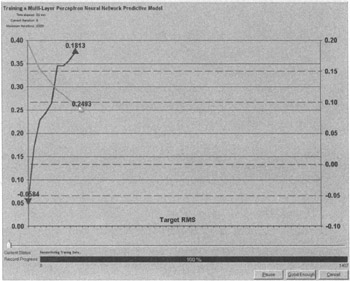8.17 Detecting Fraud
8.17 Detecting Fraud
Neural networks have been used to solve a variety of pattern-recognition problems, including the identification of prospects for offline and on-line offers by merchants. With an adequate sample of fraudulent observations, a neural network can also be trained to detect transactions where crimes are likely to take place. A neural network tool, such as SPSS Clementine's, can be used to construct a predictive model for detecting fraud. Figure 8.5 depicts a neural-network instrument monitoring a training session.

Figure 8.5: The error rate is only about 8% for this neural-network model.
Figure 8.6 shows a sensitivity report generated from this neural network tool, which prioritizes the inputs into the network for predicting fraud for a model with an accuracy rate of 91.30%. This report provides a breakdown on the relative importance of the inputs into the model. Note that the Product Category was the most important variable (.39). Interestingly, the next highest input is the percentage of individuals ages 25 to 44 in the population (.32). This can be interpreted to mean that the type of product and the age of the shoppers are some of the most important characteristics in detecting fraud.

Figure 8.6: This sensitivity instrument prioritizes the inputs for a fraud model.
Figure 8.7 shows a view of a multilayered perceptron neural network during training for a second fraud detection model using another data mining tool, KnowledgeSTUDIO from ANGOSS.

Figure 8.7: A view of the training of the perceptron neural network.
Having the ability to detect and deter on-line fraud in rea ltime is critical. This is where the ability of these data mining tools to generate code directly from their models can prove to be useful. Both SPSS Clementine and ANGOSS KnowledgeSTUDIO are capable of generating code for identifying potential perpetrators of fraud by scoring on-line transactions.
EAN: 2147483647
Pages: 232